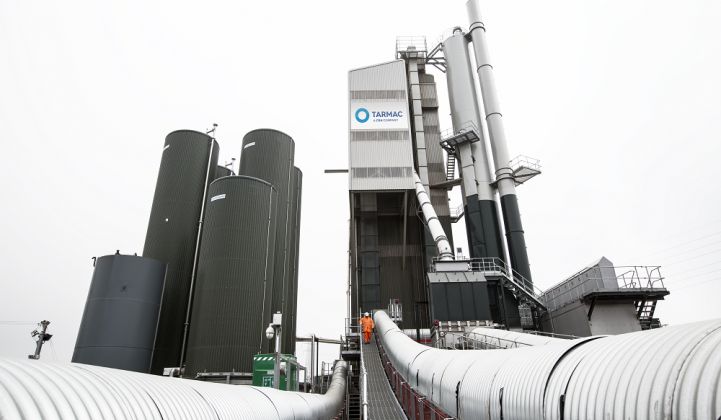Keeping power grid frequency in balance doesn’t necessarily require expensive, fast-responding power plants or utility-scale batteries. With the right technology, the same job can be done with supermarket refrigerators, or water pumps, or even tanks of hot asphalt -- or bitumen, as they call it in the U.K.
Since 2011, London-based startup Open Energi has been integrating its control systems into flexible loads at supermarket chain Sainsbury’s, water treatment plants and pumps at northwest UK water utility United Utilities, and concrete plants of Aggregate Industries.
Last month, it announced its newest partner, Tarmac -- the century-old company that owns the trademark name for the tar-and-crushed rock mixture that’s used to surface most of the world’s roadways.
Before it’s turned into roads, bitumen must be kept in enormous tanks at temperatures of about 150 degrees Celsius, a task that requires a lot of electricity. But this enormous electrical load also comes with “a huge amount of thermal inertia,” Chris Kimmett, Open Energi’s commercial manager, said in an interview this month.
In other words, they stay hot for a long time without electricity, losing only about 1.5 degrees Celsius over half an hour of being turned off, he said. And that makes for a very useful grid resource for Open Energi’s targeted grid service: fast-responding, short-duration dynamic frequency response for U.K. grid operator National Grid.
Right now, it’s working on installing its control systems at about 200 bitumen tanks at 70 sites across the U.K., he said. Each can be turned on and off, based on Open Energi’s moment-by-moment analysis of what grid operator National Grid needs to keep its system at a stable frequency of 50 hertz.
This service, known as frequency regulation in the United States, is technically challenging, requiring large-scale resources to ramp up and down within seconds. This is a much more challenging set of tasks, compared to those required from traditional demand response programs in the U.S., or the U.K.’s Short-Term Operating Reserve (STOR) program, or its new capacity markets.
Frequency response in the U.K., as in the U.S., has traditionally been done by large power plants that ramp generation up and down, Kimmett said. But that’s a rather slow and inefficient way to react to quick grid frequency changes, particularly those that can arise with more and more intermittent wind and solar power coming onto the grid.
Indeed, a 2015 study by Open Energi, National Grid and Cardiff University found that the startup was able to deliver full response from field-tested bitumen tanks within 2 seconds, compared to 5 to 10 seconds for a thermal generator. And compared to the inefficient (and thus greenhouse-gas-intensive) method of quickly ramping power plants up and down, demand-side flexibility is essentially carbon-free, he said.
Open Energi isn’t the only company targeting demand-side resources for frequency regulation. In the United States, startup Enbala has hooked up megawatts' worth of flexible loads to bid into frequency regulation markets run by mid-Atlantic grid operator PJM and Ontario, Canada’s IESO. Other demand-response providers are starting to focus on faster-acting resources to target new opportunities beyond the traditional fields of capacity markets, which deal with slower response times.
Batteries can also act much more quickly than power plants. Purpose-built, grid-scale batteries have become a significant part of PJM’s frequency regulation market, and are starting to emerge as cost-effective alternatives in new regimes being developed by Texas grid operator ERCOT, for example. But batteries also cost millions of dollars per megawatt-hour, whereas demand-side resources are already paid for.
The limitation of demand-side resources is that they weren’t built to be grid-balancing agents, but rather to do very specific and valuable jobs -- move water, or heat materials, or keep food cold. Whatever flexibility they may have must be very carefully managed, to ensure that it isn’t interfering with the critical business processes involved, Kimmett said.
“That’s what our secret sauce is -- taking a long list of constraints from all our sites, and turning it into dynamic demand,” Kimmett said. “We want to be invisible to the end customers, but invaluable to National Grid.”
The U.K. could see a much larger market for demand-side frequency response in years to come, under National Grid’s “Power Responsive” campaign, he added. Launched last year, the campaign is pushing for demand-side resources to serve from one-third to one-half of the country’s frequency response needs, which today stand at about 2 gigawatts for a nationwide peak demand of about 45 gigawatts.
Open Energi has so far taken on a long list of responsibilities to enable the industrial loads it’s signed up, he said. Those range from identifying cost-effective targets and instrumenting them to ensure their proper integration into National Grid’s market, to managing the verification and settlement of payments they receive and share with their customers.
The company, founded in 1999 to target household refrigerators as grid assets and reconfigured to address industrial loads in 2008, has received financial backing, including a £5 million round in 2012 (equivalent to about $8 million at the time), from Ombu Group, a venture firm that’s backed by pension fund Invesco.



